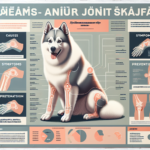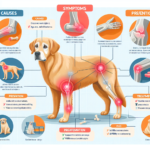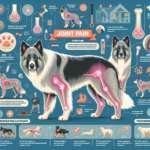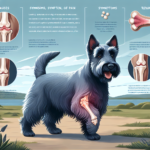Norwegian Elkhound Joint Pain: Causes, Symptoms, Prevention, and Treatment
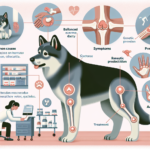
Introduction
The Norwegian Elkhound is a robust and versatile breed with a rich history dating back to ancient Scandinavia. Known for their loyalty, intelligence, and endurance, these dogs were originally bred for hunting large game such as moose and bears. With their thick double coat, erect ears, and curled tail, Norwegian Elkhounds are not only striking in appearance but also well-suited to cold climates and rugged terrains.
Despite their hardy nature, Norwegian Elkhounds are prone to certain health issues, one of the most significant being joint pain. This article will delve into the causes, symptoms, prevention, and treatment of joint pain in Norwegian Elkhounds, providing a comprehensive guide for owners to ensure their pets lead a healthy and active life.
Joint health is particularly crucial for Norwegian Elkhounds due to their active lifestyle and working heritage. Poor joint health can severely impact their mobility, quality of life, and ability to perform tasks they were bred for. Understanding the risks and taking preventive measures can help mitigate these issues.
Breed-Specific Joint Pain Risks
Genetic Predisposition
Norwegian Elkhounds are genetically predisposed to several joint-related issues, including hip dysplasia, elbow dysplasia, and arthritis. Hip dysplasia is a condition where the hip joint does not fit properly into the hip socket, leading to pain and mobility issues. Elbow dysplasia involves abnormal development of the elbow joint, causing lameness and discomfort. Arthritis, a degenerative joint disease, can also affect Norwegian Elkhounds, particularly as they age.
Age-Related Risks
As Norwegian Elkhounds age, the risk of developing joint pain increases. Typically, signs of joint issues may start to appear around middle age, which for this breed is around 5-7 years. However, some dogs may show symptoms earlier or later depending on their genetic makeup and lifestyle. Regular veterinary check-ups are essential to monitor joint health as the dog ages.
Activity Level and Joint Stress
Norwegian Elkhounds are known for their high energy levels and need for regular exercise. While their active lifestyle is beneficial for overall health, it can also contribute to joint stress, especially if the dog engages in high-impact activities like jumping or running on hard surfaces. Owners should be mindful of the types of activities their dogs participate in to minimize undue stress on the joints.
Common Symptoms of Joint Pain in Norwegian Elkhounds
General Symptoms
- Limping or favoring one leg
- Stiffness, especially after rest or sleep
- Reluctance to climb stairs or jump
- Decreased activity or playfulness
- Visible discomfort or pain when touched
- Swelling around the joints
Breed-Specific Symptoms
In Norwegian Elkhounds, joint pain may manifest more prominently in the hips and elbows due to their predisposition to hip and elbow dysplasia. Owners may notice a “bunny hopping” gait or difficulty rising from a lying position. These symptoms can be more pronounced in this breed compared to others.
When to Consult a Vet
If you observe any of the above symptoms in your Norwegian Elkhound, it is crucial to consult a veterinarian promptly. Early diagnosis and intervention can significantly improve the prognosis and quality of life for your dog. Regular veterinary check-ups are also essential for early detection of joint issues.
Preventive Measures for Joint Health
Exercise Recommendations
Regular, low-impact exercise is vital for maintaining joint health in Norwegian Elkhounds. Activities such as walking, swimming, and controlled play can help keep the joints flexible and muscles strong without causing excessive stress. Avoid high-impact activities like jumping or running on hard surfaces, which can exacerbate joint issues.
Dietary Suggestions
A balanced diet rich in essential nutrients can support joint health. Consider incorporating foods or supplements that contain glucosamine, chondroitin, and omega-3 fatty acids, which are known to promote joint health and reduce inflammation. Consult your veterinarian for specific dietary recommendations tailored to your dog’s needs.
Weight Management
Maintaining a healthy weight is crucial for reducing joint stress. Overweight dogs are at a higher risk of developing joint issues due to the additional strain on their joints. Monitor your Norwegian Elkhound’s weight and adjust their diet and exercise routine as needed to keep them at an optimal weight.
Early Screening and Monitoring
Regular veterinary check-ups and early screening for joint issues can help catch problems before they become severe. Your veterinarian may recommend X-rays or other diagnostic tests to assess joint health, especially if your dog is genetically predisposed to conditions like hip or elbow dysplasia.
Treatment Options for Joint Pain
Non-Surgical Treatments
Non-surgical treatments for joint pain in Norwegian Elkhounds include medications, physical therapy, and lifestyle adjustments. Anti-inflammatory drugs and pain relievers can help manage symptoms, while physical therapy can improve mobility and strengthen muscles around the joints. Lifestyle adjustments, such as providing a comfortable bed and avoiding high-impact activities, can also alleviate joint pain.
Surgical Options
In severe cases, surgical intervention may be necessary. Common surgical options for joint pain include hip replacement, elbow arthroscopy, and joint fusion. These procedures can significantly improve the quality of life for dogs with severe joint issues. Consult your veterinarian to determine the best course of action for your dog.
Alternative Therapies
Alternative treatments such as acupuncture, hydrotherapy, and massage can also benefit Norwegian Elkhounds with joint pain. Acupuncture can help reduce pain and inflammation, while hydrotherapy provides low-impact exercise that can improve joint mobility. Massage can help relieve muscle tension and improve circulation around the joints.
Lifestyle and Management Tips
Daily Care Routine
A consistent daily care routine can help manage and alleviate joint pain in Norwegian Elkhounds. This routine might include regular low-impact exercise, a balanced diet with joint-supporting supplements, and administering any prescribed medications. Regular grooming and monitoring for any changes in mobility or behavior are also essential.
Modifying the Home Environment
Making your home more comfortable for a dog with joint pain can significantly improve their quality of life. Consider adding ramps to help them navigate stairs, providing orthopedic beds for better joint support, and placing non-slip mats on slippery surfaces to prevent falls.
Long-Term Management
Long-term management of joint pain involves regular veterinary check-ups, ongoing monitoring of your dog’s condition, and making necessary adjustments to their care routine. Keeping your dog active and engaged with appropriate activities can help maintain their mobility and overall well-being.
FAQs About Norwegian Elkhounds and Joint Pain
What are the early signs of joint pain in Norwegian Elkhounds?
Early signs of joint pain include limping, stiffness, reluctance to move, and decreased activity levels. If you notice any of these symptoms, consult your veterinarian for a thorough evaluation.
Can joint pain in Norwegian Elkhounds be prevented?
While genetic predisposition cannot be changed, preventive measures such as regular low-impact exercise, a balanced diet, weight management, and early screening can help reduce the risk and severity of joint pain.
Are there specific foods that can help with joint health?
Yes, foods rich in glucosamine, chondroitin, and omega-3 fatty acids can support joint health. Consult your veterinarian for specific dietary recommendations tailored to your dog’s needs.
When should I consider surgery for my dog’s joint pain?
Surgery is typically considered when non-surgical treatments are no longer effective, and the dog’s quality of life is significantly impacted. Consult your veterinarian to determine the best course of action for your dog.
What alternative therapies are effective for joint pain in Norwegian Elkhounds?
Alternative therapies such as acupuncture, hydrotherapy, and massage can be effective in managing joint pain. These treatments can help reduce pain, improve mobility, and enhance overall well-being.
Conclusion
Joint pain is a significant concern for Norwegian Elkhounds, but with proper care and preventive measures, it can be managed effectively. Regular exercise, a balanced diet, weight management, and early screening are crucial for maintaining joint health. If joint pain does develop, a combination of non-surgical treatments, surgical options, and alternative therapies can help alleviate symptoms and improve your dog’s quality of life. Always consult your veterinarian for personalized advice and treatment plans to ensure your Norwegian Elkhound remains healthy and active.
By taking proactive steps and staying vigilant, you can help your Norwegian Elkhound enjoy a long, happy, and pain-free life.

